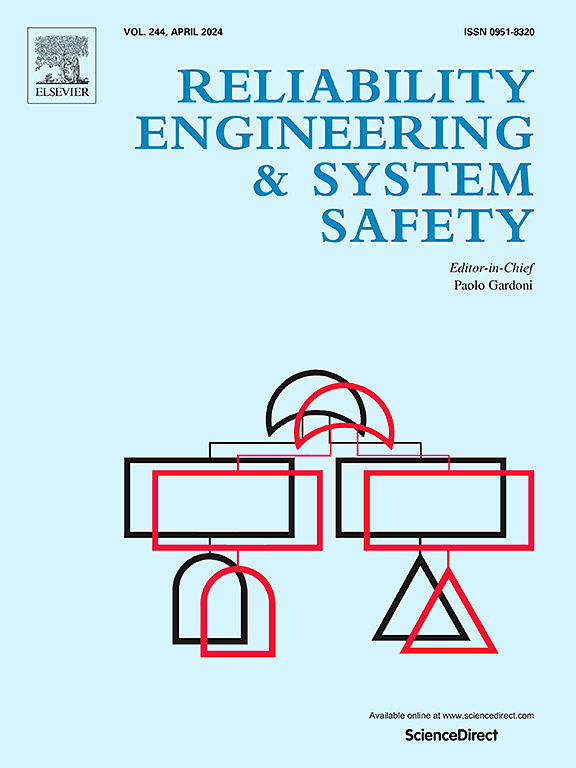A novel hybrid deep learning methodology for real-time wellhead pressure forecasting and risk warning during shale gas hydraulic fracturing
IF 9.4
1区 工程技术
Q1 ENGINEERING, INDUSTRIAL
引用次数: 0
Abstract
Accurate real-time forecasting of wellhead pressure significantly impacts risk warning and optimization of fracturing parameters. However, the complexity and non-stationary of data limit the accuracy of traditional deep learning (DL). We propose a novel hybrid DL method to enhance risk warning capabilities. The proposed method integrates the complex forecasting process into four modules. Firstly, the VMD-Fuzzy entropy module classifies intrinsic mode functions (IMFs) obtained from variational mode decomposition to significantly reduce feature redundancy. Then the Attention-GNN automatically learns latent features between multiple variables to automatically update the graph structure and incorporate controllable future input features. Additionally, the temporal–spatial feature extraction module captures spatial and temporal correlations to improve accuracy. The uncertainty quantification module employs a backtrack loss function and multi-head attention to enhance the capturing capability for critical data features. The method is verified using fracturing data from a shale gas block in Sichuan, China. The average root mean square error (RMSE), average maximum allowable error (MAE) and average R of the target area are 1.31 (MPa), 1.27 (MPa) and 0.94, respectively, which are significantly better than the traditional DL. In addition, the data of 4 overpressure well stages were used for example verification, and the corresponding traffic light risk warning system was developed. The verification results prove that the proposed method can effectively improve the warning timeliness, and provide an effective technical way to achieve intelligent and efficient hydraulic fracturing.
一种用于页岩气水力压裂井口压力实时预测和风险预警的新型混合深度学习方法
准确的井口压力实时预测对风险预警和压裂参数优化具有重要意义。然而,数据的复杂性和非平稳性限制了传统深度学习的准确性。我们提出了一种新的混合深度学习方法来增强风险预警能力。该方法将复杂的预测过程集成为四个模块。首先,vmd -模糊熵模块对变分模态分解得到的内禀模态函数(IMFs)进行分类,显著降低特征冗余;然后,Attention-GNN自动学习多个变量之间的潜在特征,自动更新图结构并纳入可控的未来输入特征。此外,时空特征提取模块捕获空间和时间相关性,以提高准确性。不确定性量化模块采用回溯损失函数和多头关注来增强对关键数据特征的捕获能力。利用中国四川某页岩气区块的压裂数据对该方法进行了验证。目标区域的平均均方根误差(RMSE)、平均最大允许误差(MAE)和平均R2分别为1.31 (MPa)、1.27 (MPa)和0.94,显著优于传统DL。并以4个超压井段数据为例进行验证,开发了相应的红绿灯风险预警系统。验证结果表明,该方法能有效提高预警及时性,为实现水力压裂智能化、高效化提供了有效的技术途径。
本文章由计算机程序翻译,如有差异,请以英文原文为准。
求助全文
约1分钟内获得全文
求助全文
来源期刊

Reliability Engineering & System Safety
管理科学-工程:工业
CiteScore
15.20
自引率
39.50%
发文量
621
审稿时长
67 days
期刊介绍:
Elsevier publishes Reliability Engineering & System Safety in association with the European Safety and Reliability Association and the Safety Engineering and Risk Analysis Division. The international journal is devoted to developing and applying methods to enhance the safety and reliability of complex technological systems, like nuclear power plants, chemical plants, hazardous waste facilities, space systems, offshore and maritime systems, transportation systems, constructed infrastructure, and manufacturing plants. The journal normally publishes only articles that involve the analysis of substantive problems related to the reliability of complex systems or present techniques and/or theoretical results that have a discernable relationship to the solution of such problems. An important aim is to balance academic material and practical applications.
 求助内容:
求助内容: 应助结果提醒方式:
应助结果提醒方式:


